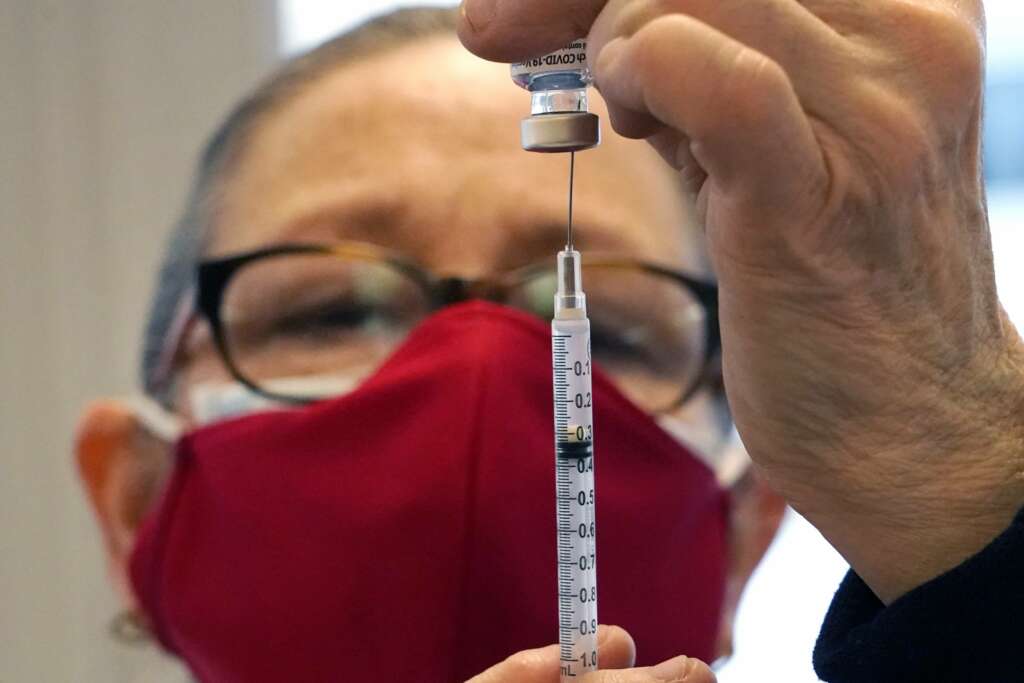
Here’s what’s happening Tuesday with the coronavirus pandemic in the U.S.:
THREE THINGS TO KNOW TODAY:
— The Biden administration will begin shipping COVID-19 vaccines to U.S. pharmacies next week as it seeks to ramp up vaccinations with the appearance of new and potentially more serious virus strains. Coronavirus coordinator Jeff Zients said Tuesday that about 6,500 pharmacies around the country will receive a total of 1 million doses of vaccine and that more locations will be added as drugmakers increase production. Pharmacies have become a mainstay for flu shots and shingles vaccines, and the industry is capable of vaccinating tens of millions of people monthly.
— Pressure is building on U.S. school systems to reopen classrooms to students who have been learning online for nearly a year. The debate is pitting politicians against teachers who haven’t been vaccinated yet against COVID-19. In Chicago, there’s so much rancor that teachers are on the brink of striking. In California, a frustrated Gov. Gavin Newsom implored schools to find a way to reopen. And in Cincinnati, some students have returned to their classrooms after a judge threw out a lawsuit brought by teachers concerned about their safety.
— Misguided attempts to protect inmates from the coronavirus at one prison “caused a public health disaster” at another, according to a report by California’s inspector general. Outdated tests failed to detect that some of the transferred inmates were already infected, and two of them later died. Corrections officials reiterated Monday that they had the best intentions. The transfer of those inmates from the California Institution for Men east of Los Angeles to San Quentin State Prison north of San Francisco at the end of May led to the deaths of 28 inmates and a correctional officer there, while infecting 75% of of the prison’s inmates, according to the report.
THE NUMBERS: According to data through Feb. 1 from Johns Hopkins University, the seven-day rolling average for daily new cases in the U.S. fell over the past two weeks, from roughly 207,509 on Jan. 18 to about 146,019 on Feb. 1. The seven-day rolling average for daily new COVID-19 deaths in the U.S. also fell slightly over the same period, from 3,239 on Jan. 18 to about 3,170 on Feb. 1.
QUOTABLE: “Starting out with a good mask to begin with is going to be key,” Dr. David Hamer, an infectious disease expert at Boston University, said about whether people should be wearing two masks to provide more protection against the coronavirus. He said wearing just one should be enough for most situations, as long as it fits well and isn’t loose.
ICYMI: The U.S. Department of Homeland Security said it won’t be making routine immigration enforcement arrests at COVID-19 vaccination sites. In a statement Monday, the agency said vaccination sites will be considered “sensitive locations” and generally off limits for enforcement actions. It said arrests would only be carried out under “the most extraordinary of circumstances.” DHS said it encourages everyone, regardless of immigration status, to receive the vaccine when they are eligible under local regulations. It is the latest example of the softer approach Biden’s administration is taking toward illegal immigration.
ON THE HORIZON: Kimchi? Beets? Broccoli? The pandemic has had a strange impact on food cravings that goes beyond the joy of comfort eating. Nearly a year into isolation, many people are embracing foods they’d long forgotten or rejected. Others have forced themselves to re-evaluate despised, health-focused foods as a way to help boost their immune systems. And with home cooking at a high, many are feeling more adventurous in the kitchen. Suddenly, that organic lentil and mushroom soup that didn’t sound so appealing pre-pandemic has become part of weekly meal routines. Fermented foods are trending, as are nostalgic, kid-friendly ones such as raisins.
___
Find AP’s full coverage of the coronavirus pandemic: https://apnews.com/hub/coronavirus-pandemic
Copyright © 2021 . All rights reserved. This website is not intended for users located within the European Economic Area.
